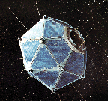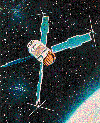|
|
X-ray Astronomy Satellites & Missions
We present here the many satellites which have detected
electromagnetic
radiation between 0.01 and 50 keV by the decade in which the
satellite was
launched. You will see, as you go through the 1960s, 70s, 80s, and 90s,
that the
sensitivity
increase in the detectors has developed greatly during
the over 30 years of X-ray
astronomy. In
addition, our ability to focus X-rays has developed enormously -- allowing us
to obtain high-quality
images of
many fascinating celestial objects.
NOTE: We include here only missions which detected non-solar X-rays
(intentionally or not).

Vela 5B
Credit: NASA
|
1960s
The first satellite which detected cosmic X-rays (not to be confused with
the first detection of cosmic X-rays!) was called
the Third Orbiting Solar Observatory, or OSO-3. Even its name tells you that it
was intended primarily to observe the Sun, which it did very well during its 2
year lifetime, but it also detected a flaring episode from the source Sco X-1
and it measured the diffuse cosmic X-ray background. In fact, none of the
satellites launched in the 1960s were dedicated to cosmic X-ray astronomy... so
all of the discoveries they made were just little gifts from the missions as
they did their "real" jobs. For example, the Vela satellites were
launched to watch for whether or not countries on Earth exploded any nuclear
bombs in the atmosphere!
|
Vela 5B |
May 1969 - June 1979
|
| Vela 5A |
May 1969 - 1979
|
| OSO 5 |
January 1969 - July 1975
|
| ESRO-2B |
May - December 1968
|
| OGO 5 |
March 1968 - June 1971
|
| OSO 4 |
October 1967 - December 1971
|
| OSO 3 |
March 1967 - November 1969
|

Uhuru
Credit: NASA
|
1970s
The decade of the 1970s was a very busy one for X-ray astronomy. The first
orbiting mission which was dedicated to celestial X-ray astronomy
was Uhuru, launched in 1970. Uhuru had a simple complement of instrumentation
covering the energy range 2-20 keV. It provided the first comprehensive view
of the entire X-ray sky. The final catalog of point sources Uhuru detected
contained 339 objects, which were primarily
binary stellar
systems, supernova remnants,
Seyfert
galaxies and
clusters of
galaxies.
Many important missions followed Uhuru in the 1970s, including ANS,
Copernicus, SAS-3, Ariel V, and OSO 8. These missions discovered X-ray
bursts, numerous pulsars, and obtained the first detailed X-ray spectra.
Another great leap forward occurred in 1977 with the launch of NASA's first
High Energy Astrophysical Observatory ( HEAO-1). HEAO-1 carried 4 major
instruments, covering the energy band 0.2 keV to 10 MeV. It generated a
catalog of approximately 850 point sources during its 18 month lifetime,
allowed the first comprehensive measurement of the diffuse X-ray background,
and performed time variability studies on millisecond time scales. This
mission was followed by HEAO-2 (also known as the Einstein Observatory), which was the first mission to use grazing incidence focusing optics for celestial astronomy (which
increased the detection sensitivity by a factor of nearly 1000!).

EXOSAT
Credit: NASA
|
1980s
During the 1980s, as NASA struggled to recover from the Space Shuttle
Challenger accident, the European, Japanese, and Russian Space Agencies
continued to launch successful X-ray astronomy missions. In particular,
this decade saw the launches of the European X-ray Observatory Satellite
(EXOSAT), Granat, the Kvant module, Tenma, and Ginga. These missions were more
modest in scale than the HEAO program in the 1970s, and were directed toward
in-depth studies of known phenomena.

ASCA
Credit: NASA
|
1990s
In the 1990s the ROSAT survey detected more than 100,000 X-ray
objects, the ASCA mission made the first sensitive measurements of the
X-ray spectra from these objects, and RXTE studied their timing
properties. These have been supplemented by a host of other
missions, with other primary goals,
but which contain instruments sensitive to high-energy cosmic radiation (such
as Ulysses and Wind). Both individually and collectively, these satellites
have provided an unprecedented view of the X-ray Universe. Satellites
launched late in the decade, Chandra and XMM, had an order of magnitude improvement in sensitivity for imaging, and promise new and exciting breakthroughs in the journey of X-ray astronomy exploration.

Chandra
Credit: NASA
|
2000s
As the 21st century began, XMM-Newton, the Chandra X-ray
Observatory, and RXTE were the work-horses of X-ray astronomy.
In early 2000 X-ray astronomy suffered from the loss of
Astro-E, which
was to provide high resolution spectroscopy through innovative
X-ray micro-calorimeters. But astronomers anticipated its
replacement in Astro-E2 in the middle of the decade. Astronomers
also looked forward to the useful data from
the X-ray telescope aboard
Swift.
The Next Generation
Beyond 2010, NASA anticipates launching revolutionary missions to
explore new frontiers in astronomy. The joint NASA-ESA Laser Interferometer Space
Antenna (LISA) will detect and measure gravitational radiation from
coalescing black holes, from stars being being ripped apart as they
fall into a black hole, and from thousands of binary star systems in
our Galaxy.
Constellation-X will provide high resolution X-ray
spectroscopy to probe matter as it falls into a black hole, as well as
probe the nature of dark matter and dark energy by observing the
formation of clusters of galaxies. All of this is part of NASA's
Beyond Einstein program.
|
